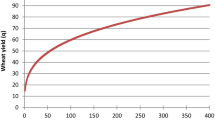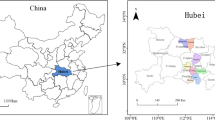Abstract
This paper presents a choice experiment approach to investigate farmers’ valuations for health risk changes associated with pesticide use in Anqiu County, China. An empirical comparison on the disparity between farmers’ willingness to pay (WTP) for a health risk reduction and willingness to accept (WTA) for the same risk increase is also conducted. Respondents were randomly assigned into the WTP group or the WTA group. Four attributes (health consequence, baseline risk, risk change size, and price) were identified and included. The results show that cancer consequence due to pesticide use decreases the utility of the farmer. A higher baseline risk has a higher WTP to reduce the risk and a higher probability of receiving compensation. If the health risk change size is bigger, it will result in a higher WTP and higher compensation. Household income, education, and age have significant and positive impacts on farmers’ WTP. Farmers who are more educated or female are more likely to accept the compensation scheme if health risks increase. The marginal WTA for the same risk change is about two times higher than the marginal WTP. The findings of this study can contribute to the literature comparing people’s WTP and WTA in a discrete choice experiment on valuing health risk changes associated with pesticide use.
Similar content being viewed by others
References
Adamowicz W, Louviere J, Williams M (1994) Combining revealed and stated preference methods for valuing environmental amenities. J Environ Econ Manag 26:271–292
Adamowicz W, Dupont D, Krupnick A, Zhang J (2011) Valuation of cancer and microbial disease risk reductions in municipal drinking water: an analysis of risk context using multiple valuation methods. J Environ Econ Manag 61:213–226
Alberini A, Chiabai A (2007) Urban environmental health and sensitive populations: how much are the Italians willing to pay to reduce their risks? Reg Sci Urban Econ 37(2):239–258
Alberini A, Ščasný M (2013) Exploring heterogeneity in the value of a statistical life, cause of death v. risk perceptions. Ecol Econ 94:143–155
Andersson H, Hole AR, Svensson M (2016) Valuation of small and multiple health risks: a critical analysis of SP data applied to food and water safety. J Environ Econ Manag 75:41–53
Bateman IJ, Carson RT, Day B, Hanemann WM, Hanley N, Hett T, Jones-Lee M, Loomes G, Mourato S, Özdemiroglu E, Pearce DW, Sugden R, Swanson J (2002) Economic valuation with stated preference techniques: a manual. Edward Elgar, Northampton
Borisova NN, Goodman AC (2003) Measuring the value of time for methadone maintenance clients: willingness to pay, willingness to accept, and the wage rate. Health Econ 12:323–334
Bosworth R, Cameron T, De Shazo JR (2009) Demand for environmental policies to improve health: evaluating community-level policy scenarios. J Environ Econ Manag 57(3):293–308
Chen R, Huang J, Qiao F (2013) Farmers’ knowledge on pest management and pesticide use in Bt cotton production in China. Chin Econ Rev 27:15–24
Damalas CA, Eleftherohorinos IG (2011) Pesticide exposure, safety issues, and risk assessment indicators. Int J Environ Res Public Health 8:1402–1419
Fan L, Niu H, Yang X, Qin W, Bento CPM, Ritsema CJ, Geissen V (2015) Factors affecting farmers’ behaviour in pesticide use: insights from a field study in northern China. Sci Total Environ 537:360–368
Feo-Valero M, Arencibia AI, Román C (2016) Analyzing discrepancies between willingness to pay and willingness to accept for freight transport attributes. Transport Res E Log Transport Rev 89:151–164
Florax RJ, Travisi CM, Nijkamp P (2005) A meta-analysis of the value of reducing pesticide risk exposure. Eur Rev Agric Econ 32:141–167
Garming H, Waibel H (2009) Pesticides and farmer health in Nicaragua: a willingness-to-pay approach to evaluation. Eur J Health Econ 10:125–133
Greene WH (2002) LIMDEP Version 8.0. Econometric Software Inc., Plainview
Grutters JP, Kessels AG, Dirksen CD, Van HD, Anteunis LJ, Joore MA (2008) Willingness to accept versus willingness to pay in a discrete choice experiment. Value Health 11(7):1110–1119
Hanemann WM (1991) Willingness to pay and willingness to accept: how much can they differ? Am Econ Rev 81(3):635–647
Hanley N, Robert W, Begona A-F (2006) Estimating the economic value of improvements in river ecology using choice experiments: an application to the water framework directive. J Environ Manag 78(2):183–193
Hao G, Yang G (2013) Pest control: risks of biochemical pesticides. Science 342:799
Hernandez AF, Gil F, Lacasaña M, Rodríguez-Barranco M, Tsatsakis AM, Requena M et al (2013) Pesticide exposure and genetic variation in xenobiotic-metabolizing enzymes interact to induce biochemical liver damage. Food Chem Toxicol 61:144–151
Horowitz JK, McConnell KE (2002) A review of WTA/WTP studies. J Environ Econ Manage 443:426–447
Huang J, Qiao F, Zhang L, Rozelle S (2001) Farm pesticide, rice production, and human health in China. EEPSEA Research Report 2001-RR3. International Development Research Center, Ottawa
Huang J, Rozelle S, Pray CE, Wang Q (2002) Plant biotechnology in the developing world: the case of China. Science 295(25):674–677
Huber J, Zwerina K (1996) The importance of utility balance inefficient choice set designs. J Mark Res 33:307–317
Itaoka K, Saito A, Krupnick A, Adamowicz W, Taniguchi T (2006) The effect of risk characteristics on the willingness to pay for mortality risk reductions from electric power generation. Environ Resource Econ 33:371–398
Jin J, Wang W, He R, Gong H (2017) Pesticide use and risk perceptions among small-scale farmers in anqiu county, china. Int J Environ Res Public Health 14(1):29
Kahneman D, Tversky A (1979) An analysis of decision under risk. Econometrica 47(2):263–292
Kamel F, Hoppin JA (2004) Association of pesticide exposure with neurologic dysfunction and disease. Environ Health Perspect 112:950–958
Khan M, Damalas CA (2015) Farmers’ willingness to pay for less health risks by pesticide use: a case study from the cotton belt of Punjab, Pakistan. Sci Total Environ 530-531:297–303
Knetsch JL (2010) Values of gains and losses: reference states and choice of measure. Environ Resour Econ 2(2):179–188
Li HZ, Zeng EY, You J (2014) Mitigating pesticide pollution in China requires law enforcement, farmer training, and technological innovation. Environ Toxicol Chem 33:963–971
Masiero L, Hensher DA (2010) Analyzing loss aversion and diminishing sensitivity in a freight transport stated choice experiment. Transp Res Part A: Policy Pract 44(5):349–358
McFadden D (1986) The choice theory approach to market research. Mark Sci 5:275–297
McIntoch E, Ryan M (2002) Using discrete choice experiments to derive welfare estimates for the provision of elective surgery: implications of discontinuous preferences. J Econ Psychol 23:367–382
Morrison M, Bennett J, Blamey R (1999) Valuing improved wetland quality using choice modeling. Water Resources Res 35(9):2805–2814
Palis FG, Flor RJ, Warburton H, Hossain M (2006) Our farmers at risk, behaviour and belief system in pesticide safety. J Public Health 28:43–48
Pearce D, Atkinson G, Mourato S (2006) Cost-benefit analysis and the environment. Recent developments. OECD, Paris
Rolfe J, Bennett J, Louviere J (2000) Choice modelling and its potential application to tropical rainforest preservation. Ecolog Econ 35:289–302
Tonin S, Anna A, Turvani M (2012) The value of reducing cancer risks at contaminated sites: are more knowledgeable people willing to pay more? Risk Anal 32(7):1157–1182
Travisi CM, Nijkamp P (2008) Valuing environmental and health risk in agriculture: a choice experiment approach to pesticides in Italy. Ecol Econ 67:598–607
Travisi CM, Nijkamp P, Vindigni G (2006) Pesticide risk valuation in empirical economics: a comparative analysis. Ecol Econ 56(4):455–474
Tsuge T, Kishimoto A, Takeuchi K (2005) A choice experiment approach to the valuation of mortality. J Risk Uncertain 31(1):73–95
Van den Berg B, Bleichrodt H, Eeckhoudt L (2005) The economic value of informal care: a study of informal caregivers’ and patients’ willingness to pay and willingness to accept for informal care. Health Econ 14:363–376
Wang H, Wang Y (2017) Factors influencing indigenous rice protection in the Yuanyang terraced rice fields of China. J Resour Ecol 8(3):287–295
Yang Y, Li Y, Wu Y (2013) Current status of insecticide resistance in Helicoverpa armigera after 15 years of Bt cotton planting in China. J Econ Entomol 106(1):375–381
Yang X, Wang F, Meng L, Zhang W, Fan L, Geissen V, Ritsema CJ (2014) Farmer and retailer knowledge and awareness of the risks from pesticide use: a case study in the Wei River catchment, China. Sci Total Environ 497-498:172–179
Zhang C, Hu R, Shi G, Jin Y, Robson MG, Huang X (2015) Overuse or underuse? An observation of pesticide use in China. Sci Total Environ 538:1–6
Acknowledgements
We would like to thank the National Natural Science Fund Project (41671170) and the Economy and Environment Program for Southeast Asia (EEPSEA) for providing the financial support to undertake this study. The authors are grateful to three anonymous referees for very helpful comments and suggestions.
Author information
Authors and Affiliations
Corresponding author
Additional information
Responsible editor: Philippe Garrigues
Rights and permissions
About this article
Cite this article
Jin, J., Wang, W., He, R. et al. Valuing health risk in agriculture: a choice experiment approach to pesticide use in China. Environ Sci Pollut Res 24, 17526–17533 (2017). https://doi.org/10.1007/s11356-017-9418-2
Received:
Accepted:
Published:
Issue Date:
DOI: https://doi.org/10.1007/s11356-017-9418-2




